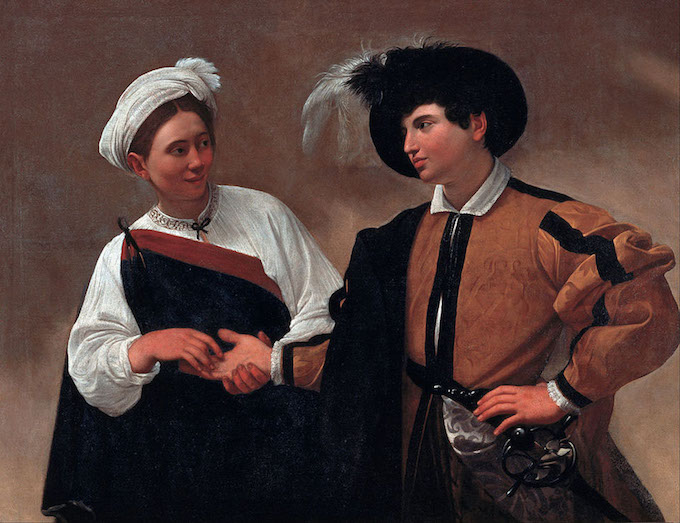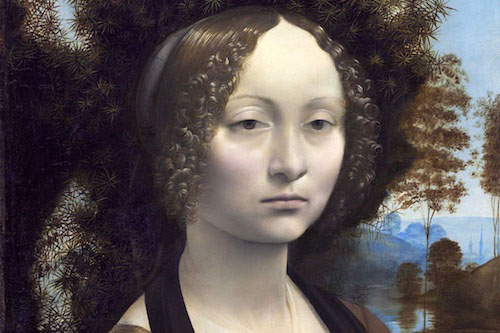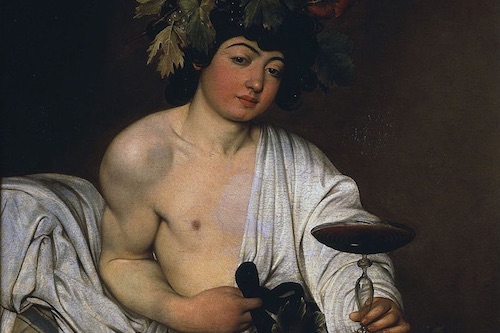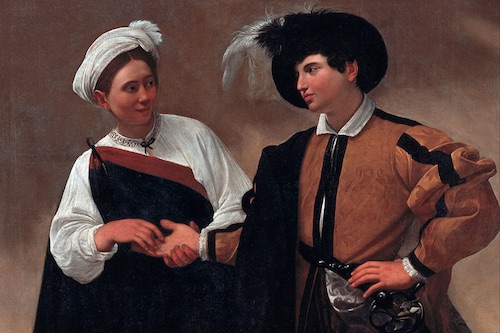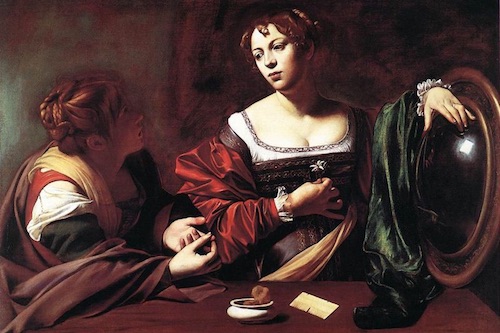Sintesi della lezione appresa da Leonardo nella bottega di Andrea del Verrocchio, maestro dell’artista a Firenze, l’opera, destinata al refettorio della chiesa fiorentina di San Bartolomeo a Monte Oliveto, è concepita per una collocazione all'interno di una copertura lignea della parete, come in uso nelle case dell'epoca, motivo delle presunte incongruenze spaziali-compositive sempre denunciate dalla critica. Nell’insieme colpiscono i motivi ornamentali del leggìo a sinistra della Vergine, desunti dal sarcofago (1472) della tomba di Giovanni e Piero de’ Medici (Firenze, San Lorenzo, Sacrestia Vecchia) realizzato dall’officina verrochiesca: elementi indiziari di una cronologia assestabile tra il 1472-73. L’atmosferica trasparenza del paesaggio roccioso al centro del fondo è precoce attestazione delle sperimentazioni prospettiche caratterizzanti i successivi capolavori leonardeschi.
Testo di Maria Teresa Tancredi
APPROFONDIMENTO
Leonardo si allontanò dall'iconografia tradizionale del tema dell'Annunciazione ambientando la scena in un giardino invece che in un luogo chiuso come voleva la tradizione medievale, in allusione al concepimento di Maria. La purezza della Vergine è allusa anche dal giglio che Gabriele le porge, secondo la tradizione, e ancora a lei, madre di Cristo e emblema della Chiesa, sono associati i cipressi che svettano sul fondo, in virtù della caratteristica di crescere allungati verso il cielo. E infine la conchiglia che sormonta il festone con foglie, frutta e fiori, è uno dei simboli mariani, legati alla coltissima concezione neoplatonica della Venere Urania, l'Afrodite celeste, la madre universale, che mediante l'amore purificato conduce l'uomo alla catarsi. I consueti canoni iconografici sono rispettati dalla collocazione l'Angelo a sinistra e della Madonna a destra, ma l'espediente di porre la figura femminile in un angolo consente di intravedere lo spazio interno della camera da letto. Un muretto che delimita il giardino si apre un passaggio verso l'ampio scorcio di paesaggio, un fiume con anse e barche, montagne punteggiate da torri e alberi. La scena si svolge dunque in uno spazio riservato e discreto ma non chiuso in quanto l'apertura al mondo naturale sembra voler sottolineare come il miracolo dell'Incarnazione divina coinvolga l'intero creato. I fiori del prato e tutte le altre specie vegetali appaiono studiati dal vero, con precisione lenticolare botanica, con attenzione da scienziato e sono solo in parte riconducibili a influssi fiamminghi. La luce è chiarissima, mattutina, e ammorbidisce i contorni delle figure, mentre l'impostazione spaziale è resa piuttosto dal digradare progressivo dei colori, soprattutto nello sfondo già immerso nella foschia dello "sfumato". In alcuni punti si possono addirittura notare le impronte digitali dell'artista, che talvolta stemperava il colore con i polpastrelli, come si riscontra sulle foglie dei festoni alla base del leggio e sulle dita della mano destra della Vergine. Il nitido rigore della prospettiva geometrica rimane nei dettagli architettonici, le proporzioni dell'edificio - una costruzione civile dai muri intonacati - del pavimento e del leggio, con un punto di fuga al centro della tavola. Lo spazio è, quindi, costruito con la luce mentre il colore rende l’atmosfera, le tinte azzurre creano la profondità, i colori chiari e freddi la lontananza i caldi il primo piano. Il candore del guarnello, la tipica veste degli angeli, si illumina del rosso del mantello soppannato da quel verde della speranza e la semplice gonnella cinta di Maria concede alla moda solo il taglio delle maniche da cui si intravede la camicia. L'incarnato dell'angelo è pallido e piatto molto diverso da quello del Battesimo di Cristo mentre la Madonna appare compostamente assorta nell'accettazione della sua missione, che sancisce con il gesto della mano aperta mentre l'altra è poggiata sulla Bibbia, aperta ad un passo di Isaia in greco e appoggiata su un velo meraviglioso, impalpabile nella sua sorprendente trasparenza. La scena sacra, tante volte ripetuta, assume un sapore particolare alla luce dell'insegnamento umanistico: l'incarnazione assicura la redenzione in un mondo però dove l'uomo vive in simbiosi con la natura, dove l'ordine assicura la calma, dove l'interno si apre all'esterno, dove tutto fluisce secondo regole precise e dove la ragione prevale sulla forza perché, come dice Leonardo nel Trattato della pittura, dove "manca la ragione suppliscono le grida".
Testo di Giovanna Lazzi
©Tutti i diritti riservati
Synthesis of the lessons learnt by Leonardo in the workshop of Andrea Verrocchio, the artist’s Florence master, this work was designed for the refectory of the Florentine Church of San Bartholomew at Monte Oliveto. It was conceived to be placed in wooden wall covering above, which explains the alleged incongruences in space and composition that critics have always pointed out. Overall, one is struck by the ornamental motifs on the lectern to the Virgin's left, gleaned from the sarcophagus of the tomb of Giovanni and Piero de’ Medici (Florence, San Lorenzo, Sacrestia Vecchia), made by Verrochio's laboratory. The atmospheric transparency of the rocky landscape mid-background is a precocious attestation of the perspective experimentations that would characterise future Leonardo masterpieces.
Text by Maria Teresa Tancredi
IN-DEPHT
Leonardo moved away from the traditional iconography of the theme of the Annunciation, setting the scene in a garden rather than the closed area in Medieval convention, a hortus conclusus, alluding to the conception of Mary. There is further reference to her purity in the lily that Gabriel hands her, in accordance with tradition, and the cypresses soaring in the background are also associated with her as mother of Christ and emblem of the church, in that they grow up towards the sky. Further, the shell surmounting the garland with its leaves, fruit and flowers is one of the symbols of Mary, linked to the cultured Neo-Platonic conception of Venus Urania, celestial Aphrodite, the universal mother, who leads man to catharsis through purified love. The usual iconographical canons are respected by placing the Angel to the left and the Madonna to the right, but the expedient of positioning the female figure in a corner reveals the space inside the bedroom. The wall bordering the garden opens up a wide view of the landscape, including a river with curves and boats, and mountains dotted with towers and trees. So the scene is played out in an area that is reserved and discrete but not closed, as the opening to the natural world may highlight how the miracle of the divine Incarnation involves all creation. The flowers on the meadow and all the other vegetable species seemed to have been studied in reality, with a precise botanical lens and scientific interest, and can only partly be attributed to Flemish influence. The clear, morning light softens the figures’ borders, while the spatial setting is dominated by the progressive fading of colour, especially in the background, which is already immersed in the "sfumato" mist. Some elements actually reveal the fingerprints of the artist, who sometimes tempered the colours with his fingertips, as shown by the garland leaves at the base of the lectern and the fingers of the Virgin’s right hand. The sharp rigour of geometrical perspective remains in the architectural details, the proportions of the floor, the building – a civilian construction with plastered walls – and the lectern, with a vanishing point at the centre of the table. The space is, then, formed with light, while colour fashions atmosphere, with depth created by the blue tints create depth, distance by the clear, cold colours, and the foreground by the cold colours. Light bounces off the wall, illuminating the characters’ faces and hair and modelling the architectural elements and the flowing drapery of the dresses in their classical cadences. The white of the fringe, the typical angel’s attire, is brightened by the red of the cloak, underlain by the green of hope and Mary’s simple girded skirt concedes to fashion only the cut of the sleeve, showing her blouse. The incarnation of the angel is pale and flat, quite unlike the one in the Baptism of Christ, while the Madonna appears composed, absorbed in accepting her mission, which she seals by opening one hand, as the other is placed on the Bible, displaying a passage from Isaiah, symbolising the truthfulness of Scripture, protected, in a mark of sacred respect, by the wondrous veil, impalpable in its surprising transparency. The Madonna appears composed, absorbed in accepting her mission, which she seals by opening one hand, as the other is placed on the Bible, displaying a passage from Isaiah, symbolising the truthfulness of Scripture, protected, in a mark of sacred respect, by the wondrous veil, impalpable in its surprising transparency. This oft-repeated holy scene takes on peculiar style in the light of humanistic teaching: the incarnation ensures redemption in a word where man lives in symbiosis with nature, order guarantees calm, the internal opens to the external, everything flows according to precise rules, and reason prevails over force because, as Leonardo wrote in the Treatise on Painting, “where reason fails, cries beseech".
Text by Giovanna Lazzi
©All Rights Reserved
Synthèse de l’enseignement tiré par Léonard de l’atelier d’Andrea del Verrocchio, maître de l’artiste à Florence, l’œuvre, destinée au réfectoire de l’église florentine de San Bartolomeo à Monte Oliveto, est conçue pour être placée à l’intérieur d’un revêtement mural en bois, selon l’usage dans les demeures de l’époque, ce qui expliquerait les présumées incongruences spatiales dans la composition que la critique a toujours dénoncées.
Léonard s’éloigna de l’iconographie traditionnelle du thème de l’Annonciation en situant la scène dans un jardin plutôt que dans un lieu clos comme le voulait la tradition médiévale, en référence à la conception de Marie. La pureté de la Vierge est également suggérée par le lys que Gabriel lui tend, selon la tradition, et c’est encore à elle, mère du Christ et emblème de l’Eglise, que sont associés les cyprès qui se dressent en arrière-plan, eu égard à leur particularité de pousser allongés vers le ciel. Enfin le coquillage qui surmonte le feston orné de feuilles, fruits et fleurs, est un symbole marial, lié à la très savante conception néoplatonicienne de la Vénus Uranie, l’Aphrodite céleste, la mère universelle, qui grâce à l’amour purifié conduit l’homme à la catharsis. Les canons iconographiques habituels sont respectés par la position de l’Ange à gauche et de la Madone à droite, mais l’expédient consistant à placer le personnage féminin dans un coin permet d’entrevoir l’espace intérieur de la chambre à coucher. Un muret qui délimite le jardin ouvre un passage vers la vue étendue du paysage, un fleuve avec ses anses et des barques, des montagnes ponctuées de tours et d’arbres. La scène se déroule donc dans un espace réservé et discret mais pas fermé dans la mesure où l’ouverture sur le monde naturel semble vouloir souligner la manière dont le miracle de l’Incarnation divine implique la totalité de la création. Les fleurs du pré et toutes les autres espèces végétales apparaissent étudiées d’après la réalité, avec une précision botanique lenticulaire, une attention de scientifique et ne sont qu’en partie attribuables aux influences flamandes. La lumière est très claire, matinale, et adoucit les contours des personnages, tandis que la disposition de l’espace est plutôt rendue par le dégradé progressif des couleurs, surtout pour l’arrière-plan déjà plongé dans la brume du sfumato. A certains endroits on peut même remarquer les empreintes digitales de l’artiste, qui parfois délayait la couleur du bout des doigts, comme on le retrouve sur les feuilles des festons à la base du pupitre et sur les doigts de la main droite de la Vierge. La rigueur nette de la perspective géométrique réside dans les détails architecturaux, les proportions de l’édifice – une construction civile aux murs enduits – du dallage et du pupitre, avec le point de fuite au centre du panneau. L’espace se construit donc avec la lumière tandis que la couleur rend l’atmosphère, les teintes azurées créent la profondeur, les couleurs claires et froides le lointain et les couleurs chaudes le premier plan. La candeur du guarnello, le vêtement caractéristique des anges, s’illumine du rouge du manteau doublé de ce vert de l’espoir et la simple jupe avec ceinture de Marie ne concède à la mode que l’ouverture dans les manches à travers laquelle on aperçoit la chemise. La carnation de l’ange est pâle et plate, bien différente du Baptême du Christ, tandis que la Madone apparaît sobrement absorbée dans l’acceptation de sa mission, qu’elle approuve d’un geste de sa main ouverte quand l’autre est posée sur la Bible, ouverte sur un passage d’Isaïe en grec et reposant sur un voile merveilleux, impalpable dans sa surprenante transparence.
Texte de Giovanna Lazzi
©Tous droits réservés
